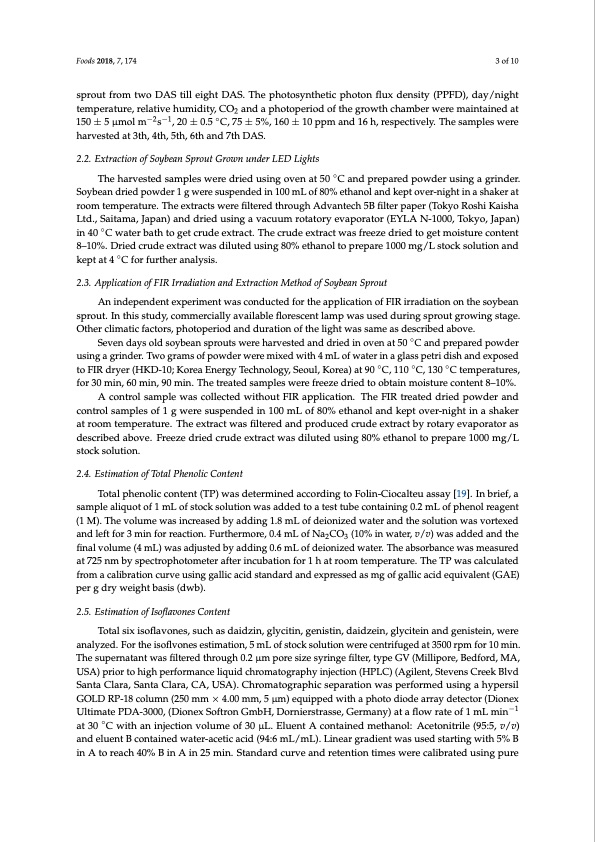
PDF Publication Title:
Text from PDF Page: 003
Foods 2018, 7, 174 3 of 10 sprout from two DAS till eight DAS. The photosynthetic photon flux density (PPFD), day/night temperature, relative humidity, CO2 and a photoperiod of the growth chamber were maintained at 150 ± 5 μmol m−2s−1, 20 ± 0.5 ◦C, 75 ± 5%, 160 ± 10 ppm and 16 h, respectively. The samples were harvested at 3th, 4th, 5th, 6th and 7th DAS. 2.2. Extraction of Soybean Sprout Grown under LED Lights The harvested samples were dried using oven at 50 ◦C and prepared powder using a grinder. Soybean dried powder 1 g were suspended in 100 mL of 80% ethanol and kept over-night in a shaker at room temperature. The extracts were filtered through Advantech 5B filter paper (Tokyo Roshi Kaisha Ltd., Saitama, Japan) and dried using a vacuum rotatory evaporator (EYLA N-1000, Tokyo, Japan) in 40 ◦C water bath to get crude extract. The crude extract was freeze dried to get moisture content 8–10%. Dried crude extract was diluted using 80% ethanol to prepare 1000 mg/L stock solution and kept at 4 ◦C for further analysis. 2.3. Application of FIR Irradiation and Extraction Method of Soybean Sprout An independent experiment was conducted for the application of FIR irradiation on the soybean sprout. In this study, commercially available florescent lamp was used during sprout growing stage. Other climatic factors, photoperiod and duration of the light was same as described above. Seven days old soybean sprouts were harvested and dried in oven at 50 ◦C and prepared powder using a grinder. Two grams of powder were mixed with 4 mL of water in a glass petri dish and exposed to FIR dryer (HKD-10; Korea Energy Technology, Seoul, Korea) at 90 ◦C, 110 ◦C, 130 ◦C temperatures, for 30 min, 60 min, 90 min. The treated samples were freeze dried to obtain moisture content 8–10%. A control sample was collected without FIR application. The FIR treated dried powder and control samples of 1 g were suspended in 100 mL of 80% ethanol and kept over-night in a shaker at room temperature. The extract was filtered and produced crude extract by rotary evaporator as described above. Freeze dried crude extract was diluted using 80% ethanol to prepare 1000 mg/L stock solution. 2.4. Estimation of Total Phenolic Content Total phenolic content (TP) was determined according to Folin-Ciocalteu assay [19]. In brief, a sample aliquot of 1 mL of stock solution was added to a test tube containing 0.2 mL of phenol reagent (1 M). The volume was increased by adding 1.8 mL of deionized water and the solution was vortexed and left for 3 min for reaction. Furthermore, 0.4 mL of Na2CO3 (10% in water, v/v) was added and the final volume (4 mL) was adjusted by adding 0.6 mL of deionized water. The absorbance was measured at 725 nm by spectrophotometer after incubation for 1 h at room temperature. The TP was calculated from a calibration curve using gallic acid standard and expressed as mg of gallic acid equivalent (GAE) per g dry weight basis (dwb). 2.5. Estimation of Isoflavones Content Total six isoflavones, such as daidzin, glycitin, genistin, daidzein, glycitein and genistein, were analyzed. For the isoflvones estimation, 5 mL of stock solution were centrifuged at 3500 rpm for 10 min. The supernatant was filtered through 0.2 μm pore size syringe filter, type GV (Millipore, Bedford, MA, USA) prior to high performance liquid chromatography injection (HPLC) (Agilent, Stevens Creek Blvd Santa Clara, Santa Clara, CA, USA). Chromatographic separation was performed using a hypersil GOLD RP-18 column (250 mm × 4.00 mm, 5 μm) equipped with a photo diode array detector (Dionex Ultimate PDA-3000, (Dionex Softron GmbH, Dornierstrasse, Germany) at a flow rate of 1 mL min−1 at 30 ◦C with an injection volume of 30 μL. Eluent A contained methanol: Acetonitrile (95:5, v/v) and eluent B contained water-acetic acid (94:6 mL/mL). Linear gradient was used starting with 5% B in A to reach 40% B in A in 25 min. Standard curve and retention times were calibrated using purePDF Image | Effect of Artificial LED Light and Far Infrared Irradiation on soybean

PDF Search Title:
Effect of Artificial LED Light and Far Infrared Irradiation on soybeanOriginal File Name Searched:
foods-07-00174.pdfDIY PDF Search: Google It | Yahoo | Bing
Cruise Ship Reviews | Luxury Resort | Jet | Yacht | and Travel Tech More Info
Cruising Review Topics and Articles More Info
Software based on Filemaker for the travel industry More Info
The Burgenstock Resort: Reviews on CruisingReview website... More Info
Resort Reviews: World Class resorts... More Info
The Riffelalp Resort: Reviews on CruisingReview website... More Info
| CONTACT TEL: 608-238-6001 Email: greg@cruisingreview.com | RSS | AMP |